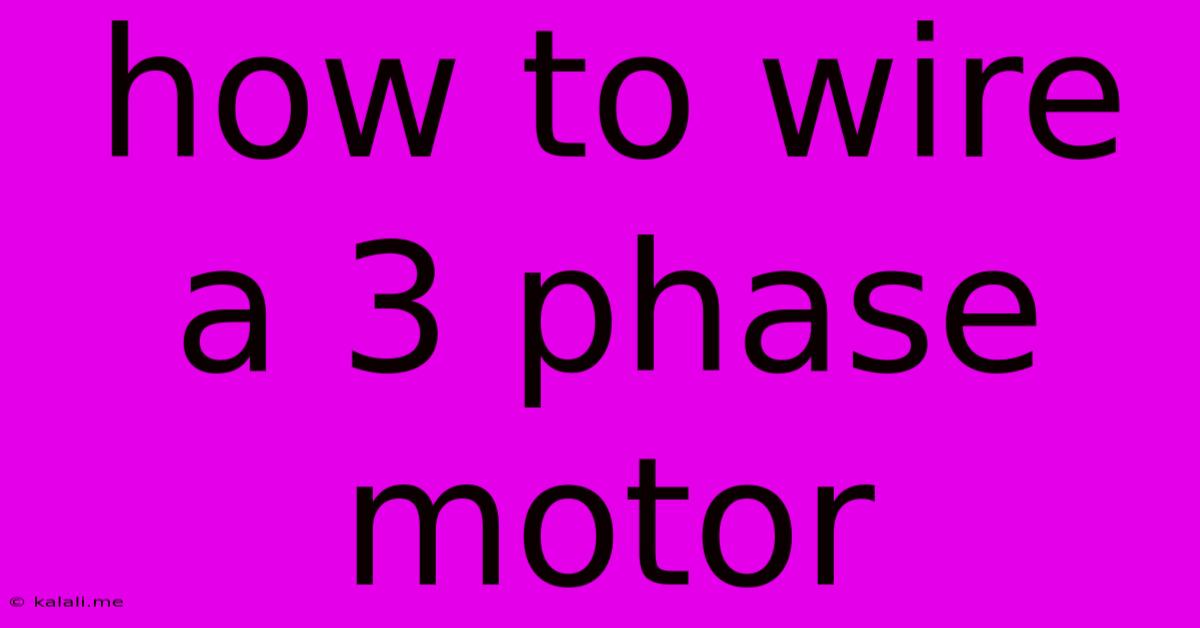How To Wire A 3 Phase Motor
Kalali
May 25, 2025 · 4 min read

Table of Contents
How to Wire a Three-Phase Motor: A Comprehensive Guide
Wiring a three-phase motor might seem daunting, but with a clear understanding of the process and safety precautions, it's a manageable task. This guide provides a step-by-step walkthrough, covering essential safety measures, identifying motor components, and connecting the wires correctly. This will ensure your motor operates efficiently and safely. Remember to always prioritize safety and consult a qualified electrician if you are unsure about any aspect of this process.
Understanding Three-Phase Power and Motor Components
Before diving into the wiring process, let's clarify the basics. Three-phase power consists of three separate alternating current (AC) power lines, each carrying current 120 degrees out of phase with the others. This provides a more efficient and powerful supply than single-phase power, making it ideal for industrial machinery and larger motors.
Your three-phase motor will have several key components:
- Terminal Box: This enclosure houses the motor's connection terminals. You'll find six or more wires emanating from the motor windings within.
- Terminal Block: Inside the terminal box, you'll see a terminal block, with numbered terminals for connecting the incoming power and internal windings.
- Motor Windings: These are the internal coils of wire that produce the magnetic field necessary for motor operation. They are typically connected in either a star (wye) or delta configuration.
- Nameplate: This plate provides crucial information, including voltage, amperage, horsepower, and connection type (star or delta). This information is crucial for correct wiring.
Safety First: Essential Precautions
Working with electricity can be dangerous. Always adhere to these safety guidelines:
- Lockout/Tagout: Before commencing any work, disconnect the power supply completely and use a lockout/tagout device to prevent accidental re-energization.
- Personal Protective Equipment (PPE): Wear appropriate safety gear, including insulated gloves, safety glasses, and closed-toe shoes.
- Verify Power Off: Use a voltage tester to double-check that the power is indeed off before touching any wires or components.
- Work Area: Ensure a clean and well-lit work area to avoid accidents.
Step-by-Step Wiring Process
The exact wiring process will depend on your motor's nameplate specifications (voltage, amperage, and connection type). However, the general steps are as follows:
-
Identify the Connection Type: Check the motor's nameplate to determine whether it's wired for a star or delta connection. A star connection uses all six terminals, while a delta connection typically uses only three.
-
Prepare the Wires: Ensure that the incoming three-phase power wires are properly sized to handle the motor's amperage rating. Strip the insulation from the ends of the wires, exposing sufficient length for secure connections.
-
Connect the Wires: Based on the connection type (star or delta), connect the incoming power wires to the motor's terminal block according to the wiring diagram provided on the motor's nameplate or in the motor's manual. Accurate connection is crucial.
- Star Connection: Each incoming power wire connects to one of the three terminals representing the start points of the windings. The remaining three terminals, the end points of each winding are connected together (usually internally connected at the motor).
- Delta Connection: Each incoming power wire connects to one winding, completing a closed triangle (delta). This connection method is usually used for higher voltage applications.
-
Double Check Connections: After making all the connections, thoroughly check each one for tightness and proper alignment. Loose connections can lead to overheating and potential hazards.
-
Secure the Terminal Box: Ensure that the terminal box cover is firmly secured to protect the connections from dust and moisture.
-
Restore Power: Carefully restore the power supply after completing all wiring checks.
-
Test the Motor: After power restoration, test the motor under light load to ensure it starts and operates correctly. Monitor the motor for any unusual sounds or excessive heat.
Troubleshooting Common Issues
- Motor Doesn't Start: Check all connections and ensure the power supply is functioning correctly.
- Motor Overheats: This can be caused by several factors, including incorrect wiring, faulty bearings, or excessive load.
- Unusual Noises: Unusual noises could indicate bearing wear or other mechanical problems.
If you encounter issues, consult a qualified electrician for assistance.
This comprehensive guide covers the essentials of wiring a three-phase motor. Always prioritize safety and consult professional help if you feel unsure at any point. Remember, a properly wired motor is essential for safe and efficient operation. By carefully following these steps and prioritizing safety, you can successfully wire your three-phase motor.
Latest Posts
Latest Posts
-
How To Say Cat In Japanese
May 26, 2025
-
The Force Exerted By Point Charge
May 26, 2025
-
How To Sweap To Empty Hand Dark And Darker
May 26, 2025
-
Why Didnt The Ootp Tell Harry About Retrieving The Prophecy
May 26, 2025
-
How To Stop Cats From Scratching At The Door
May 26, 2025
Related Post
Thank you for visiting our website which covers about How To Wire A 3 Phase Motor . We hope the information provided has been useful to you. Feel free to contact us if you have any questions or need further assistance. See you next time and don't miss to bookmark.